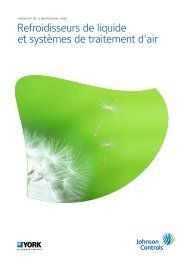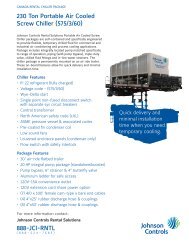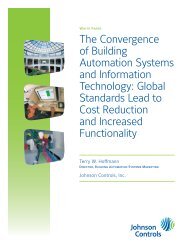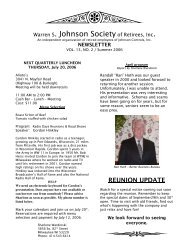Rxf - Johnson Controls Inc.
Rxf - Johnson Controls Inc.
Rxf - Johnson Controls Inc.
Create successful ePaper yourself
Turn your PDF publications into a flip-book with our unique Google optimized e-Paper software.
070.410-IOM (JUL 11)<br />
Page 24<br />
suction check valve bypass. Close disconnect switches for<br />
the compressor and (if applicable) the oil pump motor starters.<br />
Start the unit.<br />
COALESCER OIL RETURN STRAINER<br />
1. Push [STOP] key to shut down the unit. Open disconnect<br />
switches for the compressor.<br />
2. Isolate the package by closing all package valves to the<br />
system. Tag all closed valves.<br />
Open any sole noid valves or other<br />
valves that may trap liquid between<br />
the isolation valves and other package<br />
valves to prevent injury or damage to components.<br />
SLOWLY vent separator to low-side system pressure using<br />
the suction check valve bypass. NOTE: Recover or transfer<br />
all refrigerant vapor, in accor dance with local ordinances,<br />
before opening to atmo sphere. The separa tor MUST be<br />
equal ized to atmo spher ic pres sure.<br />
RXF ROTARY SCREW COMPRESSOR UNITS<br />
MAINTENANCE<br />
Oil entrained refriger ant may vaporize,<br />
causing a separa tor pressure<br />
increase. Repeat transfer and recovery<br />
procedure, if neces sary.<br />
3. Close strainer isolation valves. Remove the large plug<br />
from the bottom of the strainer and remove the element<br />
from the strainer.<br />
4. Wash the element in solvent and blow clean with air.<br />
5. Replace the cleaned element and removed plug. Open<br />
strainer isolation valves.<br />
6. Isolate the low pressure transducer, PE-4, to prevent damage<br />
during pressurization and leak test.<br />
7. Pressurize and leak test. Evacuate unit to 29.88" Hg (1000<br />
microns).<br />
8. Open the suction and discharge service valves, and the<br />
low pressure transducer. Close discon nect switches for the<br />
compressor. Start the unit.<br />
LI Q UID INJECTION STRAINER<br />
To clean the liq uid injection strainer the unit must be shut<br />
down. The procedure is as follows:<br />
1. Push [STOP] key to shut down the unit, then open disconnect<br />
switches for the compressor.<br />
2. Close the liquid supply service valve located before the<br />
liquid solenoid.<br />
3. Immediately screw in the manual solenoid valve stem<br />
to relieve liquid refrigerant pressure trapped between the<br />
solenoid and the service valve.<br />
4. Close the service valve located between the compressor<br />
and the liquid injection thermal expansion valve.<br />
5. Carefully loosen capscrews securing the strainer cover to<br />
the strainer. Allow pressure to relieve slowly.<br />
6. When all entrapped refrigerant has been relieved, carefully<br />
remove loosened capscrews (as liquid refrigerant is some times<br />
caught in the strainer), strain er cover, and strainer basket.<br />
7. Wash the strainer basket and cover in sol vent and blow<br />
clean with air.<br />
8. Reassemble the strainer.<br />
9. Open the service valve between the compressor and the<br />
liquid injection thermal expansion valve, purge entrained air,<br />
and check for leakage.<br />
10. Screw out the manual solenoid valve stem.<br />
11. Carefully open the liquid supply service valve.<br />
12. Leak test.<br />
13. Close disconnect switches for compressor starter.<br />
14. Start the unit.<br />
OIL PUMP STRAINER (Optional)<br />
To clean the full-lube oil pump strainer, the unit must be shut<br />
down. The proce dure is as follows:<br />
1. Push [STOP] key to shut down the unit, then open the<br />
discon nect switches for the compressor and (if applicable)<br />
the oil pump motor starters.<br />
2. Close strainer service valves.<br />
3. Open the drain valve located in the strainer cover and<br />
drain the oil into a container.<br />
4. Remove the capscrews securing the strainer cover, strainer<br />
cover gasket, and element. Retain the gasket.<br />
5. Wash the element in solvent and blow it clean with air.<br />
6. Wipe the strainer body cavity clean with a lint-free clean cloth.<br />
7. Replace the cleaned element and gasket, then reattach<br />
the cover using the retained capscrews.<br />
8. Reinstall the drain plug and open the strainer service valves.<br />
9. Check for leakage.<br />
10. Close the disconnect switches for the compressor and<br />
(if applicable) the oil pump motor starters.<br />
11. Start the unit.<br />
SUCTION CHECK VALVE BYPASS<br />
A 1/4" angle valve is installed between the compressor and<br />
suction flange that can be used as a suction valve bypass.<br />
This feature has several uses including reducing starting<br />
torque, improving oil quality, and relieving the refrigerant<br />
to low side for servicing.<br />
In most cases, the valve should be left open approximately 1 to<br />
2 turns at all times. If the compressor back-spins or too much<br />
oil foaming is experienced while venting, partially close valve<br />
to slow speed of equalization. If system is on AUTO CYCLE and<br />
short cycling occurs, the valve must be closed.<br />
To relieve refrigerant to low side, close separator discharge<br />
service valve. Slowly open bypass valve (if closed) and wait<br />
for pressure to equalize. Close bypass and suction service<br />
valves before evacuating the unit.<br />
COALESCER FILTER ELEMENT<br />
Use of coalescer filter elements<br />
other than Frick may cause warranty<br />
claim to be denied.










![[PDF] Intelligent Fire Annunciator IFA-1000 - Johnson Controls Inc.](https://img.yumpu.com/7424420/1/190x245/pdf-intelligent-fire-annunciator-ifa-1000-johnson-controls-inc.jpg?quality=85)





